Eating a healthy and balanced diet is important for maintaining good health and well-being. However, with so many different foods and diets out there, it can be difficult to know where to start when it comes to making a healthy diet plan. In this article, we will discuss the 7 things you need for a balanced diet, healthy ways to diet, and provide some healthy food recipes and ideas to help you get started.
What is a Healthy Diet?
A healthy diet is one that includes a variety of nutritious foods from all the different food groups. This includes fruits, vegetables, whole grains, lean proteins, and healthy fats. A healthy diet should also limit the intake of processed and high-calorie foods, as well as sugary drinks.
How to Create a Healthy Diet Plan
Creating a healthy diet plan can be a simple process if you follow these steps:
- Set realistic goals: Start by setting realistic goals for yourself. This could be as simple as adding more fruits and vegetables to your diet or reducing your intake of sugary drinks.
- Plan your meals: Plan your meals in advance to ensure that you are getting a variety of healthy foods in your diet. You can use a healthy food chart to guide you.
- Shop smart: When you go grocery shopping, choose healthy foods that are in season and locally grown. This can help you save money and get fresher produce.
- Cook at home: Cooking at home can be a great way to control the ingredients in your meals and ensure that you are eating healthy foods. Try out some healthy food recipes to get started.
- Portion control: Portion control is important for maintaining a healthy weight and avoiding overeating. Use smaller plates and cups to help you control your portions.
- Stay hydrated: Drink plenty of water and avoid sugary drinks to stay hydrated and healthy.
- Be flexible: Remember to be flexible and allow yourself some indulgences from time to time. A healthy diet should be enjoyable and sustainable.

7 Things You Need for a Balanced Diet
To create a healthy diet plan, it is important to include these 7 things in your diet:
- Fruits and vegetables: These provide essential vitamins, minerals, and fiber.
- Whole grains: These provide energy and fiber, and help regulate blood sugar levels.
- Lean proteins: These provide essential amino acids for building and repairing tissues.
- Healthy fats: These are important for brain function, heart health, and hormone production.
- Low-fat dairy: These provide calcium and other essential nutrients.
- Water: This helps keep you hydrated and is essential for many bodily functions.
- Limit processed and high-calorie foods: These should be limited as they can contribute to weight gain and health problems.
Healthy Food Ideas
Here are some healthy food ideas to help you get started:
- Breakfast: Oatmeal with fruit, a spinach and mushroom omelet, or a smoothie made with Greek yogurt and berries.
- Lunch: Grilled chicken or fish with a side salad, a turkey and avocado wrap, or a lentil soup with whole grain bread.
- Dinner: Grilled salmon with roasted vegetables, whole grain pasta with tomato sauce and lean ground beef, or a quinoa and black bean bowl.
- Snacks: Apple slices with almond butter, raw veggies with hummus, or a small handful of nuts.
Heart-Healthy Food
Heart-healthy foods are those that can help improve heart health and reduce the risk of heart disease. Some heart-healthy foods include:
- Fatty fish, such as salmon or tuna, which are high in omega-3 fatty acids that can help reduce inflammation and lower triglyceride levels.
- Whole grains, such as brown rice or quinoa, which are high in fiber and can help lower cholesterol levels.
- Leafy greens, such as spinach or kale, which are high in vitamins, minerals, and antioxidants that can help reduce inflammation and improve heart health.
- Berries, such as blueberries or strawberries, which are high in antioxidants that can help reduce inflammation and improve heart health.

Healthy Foods to Lose Weight
If you are looking to lose weight, incorporating these healthy foods into your diet can help:
- High-fiber foods, such as whole grains, fruits, and vegetables, can help keep you feeling full and satisfied, and can help you eat less overall.
- Lean proteins, such as chicken, fish, and beans, can help build and maintain muscle mass, which can help boost your metabolism and burn more calories.
- Healthy fats, such as those found in nuts, seeds, and avocado, can help keep you feeling full and satisfied, and can help regulate blood sugar levels.
- Low-calorie foods, such as leafy greens, cucumbers, and tomatoes, can help fill you up without adding a lot of calories to your diet.
Healthy Fast Food
If you are on the go and need to grab something quickly, here are some healthy fast food options:
- Grilled chicken or fish sandwiches or wraps, without mayonnaise or cheese.
- Salads with grilled chicken or shrimp, and a low-fat dressing.
- Fresh fruit cups or smoothies.
- Vegetable-based soups.
Conclusion
In conclusion, making a healthy diet plan can be a simple and enjoyable process if you follow the right steps. By incorporating a variety of nutritious foods into your diet, planning your meals in advance, and being flexible, you can create a healthy and sustainable diet plan. Remember to stay hydrated, limit processed and high-calorie foods, and allow yourself some indulgences from time to time. And don’t forget to try out some healthy food recipes and ideas to keep your meals interesting and delicious.






